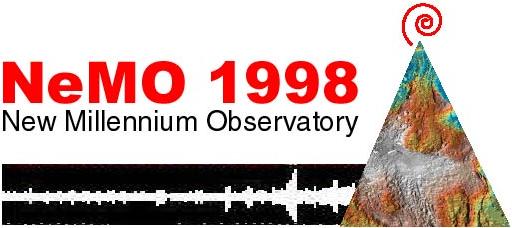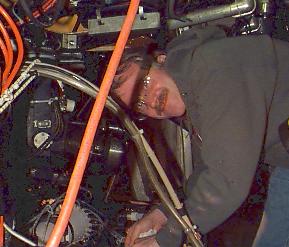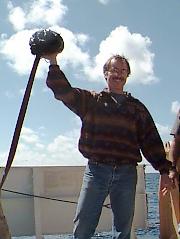WHAT'S NEW:
Eruption Confirmed!
New lava (rumbleometer stuck in flow) SE rift zone
(posted 9/1/98)
BACKGROUND:
Technology (ROV, ships, etc.)
Other 1998 Axial cruise reports
EXPEDITION:
Science Objectives
Calendar
Today's Science News
Participant Perspective
Teacher Logbook
EDUCATION:
Curriculum
Teacher Observations
Questions/Answers from sea
MULTIMEDIA:
(video clips, animations, sounds)

Logbook
September 7, 1998
September 7, 1998
Contents:
Science Report
Daily Science Report - Sep 7
ship's location = 45 56.0N/130 00.9W
The 25 knot winds we had yesterday subsided in the afternoon and so we cut short our SeaBeam survey and ROPOS was back in the water by evening for dive 468 at the ASHES vent field. The main aim of the dive was to test out the newly repaired fluid sampler (see Partipant Perspective for today) and do coordinated sampling with the SUAVE chemical analyzer at diffuse (low-temperature) vent sites. The fluid sampler worked well, but the sampling arm was damaged, so the dive was ended after only 4 hours to make repairs. Additional rockcores were collected between dives, and now ROPOS is back at ASHES to continue water sampling on dive 469. We will also be collected some Imagenex and digital camera data at ASHES.
Listing of all Science News postings
Life at Sea: Participant Perspective
Dave Butterfield
NOAA Vents Program, Seattle

|
Dave fitting the fluid sampler to ROPOS after successfully installing the parts delivered from the Air Force. |
A major component of our work during this NEMO98 cruise is to investigate the interconnections between volcanic processes, the chemistry of hydrothermal fluids, and the nature of the micro-organisms and animals living in the vent environment. In order to do this, we have to collect hydrothermal fluid samples. It probably seems strange to go to great lengths to collect hot water from the bottom of the ocean, but fluid chemistry is like our sense of smell, and it tells us what is cooking below the seafloor where water reacts with hot rock, and hyperthermophilic microbes grow. Never mind that the vent fluids smell like rotten eggs.
The technology we use to collect water samples with remotely operated vehicles has evolved over the last 5 years. In 1993, we adapted the titanium water samplers used since the late 1970's on Alvin and other manned submersibles for use on the ROPOS ROV. This was extremely inefficient, and I vowed not to do vent fluid sampling again with an ROV until I could come up with a more effective technology. The West Coast National Undersea Research Center provided funding to PMEL to build a sampler to take 7 titanium samples per dive, and this sampler, called MS95 for short, was completed and used in 1996. Titanium is used because it is very strong and very resistant to corrosion, so that it doesn't contaminate the vent fluid samples. The finished sampler outfitted with 7 titanium samplers, each with an electrical actuator in a titanium housing, connected by titanium tubing and fittings, was a beautiful thing to behold for anyone who appreciates metals.
Oceanography is sometimes a risky business, as is any undertaking at sea. During the maiden voyage of the fluid sampler, it was lost with ROPOS during a severe storm. I'll never forget watching the tether sever and seeing ROPOS disappear along with the new fluid sampler. The original ROPOS and the fluid sampler have not been seen since that stormy night.
After regrouping, I decided it was definitely worth trying again to make a fluid sampling tool for ROV's. This time, however, the sampler would have to be simpler, lighter, more versatile, and less expensive. With financial support from Dave Epp of the National Science Foundation, and with the engineering support at PMEL, I settled on the concept of pumping vent fluid through a system of tubing with a flushing pump, then pulling the fluid with a second pump into individual containers selected by a multi-port valve. The system would require only electrical power and data communication from the ROV, with no requirements for hydraulics, and relatively few cables, so that it could be adapted to different vehicles. McLane Research Labs of East Falmouth, Massachusetts, built the multi-port valve and the pumps, and PMEL engineers designed the mechanical and electronic aspects. The new sampler was completed just in time for testing and use during this cruise.
After working hard on this project for months, it was finally ready to be used on a dive. But, there were a few more obstacles to overcome. A simple error just before the planned dive resulted in a blown component for which there was no spare. When you are 300 miles out to sea, and you don't have a spare part, you can't just get out your credit card and ask for overnight delivery. We were stuck.
After considering the options, giving up was not among them. I contacted McLane
on the weekend, and they got to work putting together the spare components
needed for the fluid sampler. Resourceful colleagues at PMEL reached out to
find a way to get the parts to the ship. I was expecting perhaps a chartered
fishing boat to come out and meet the ship with the parts, but what we got
instead was a special air drop from an Air Force C141 jet on a training mission
out of McCord Air Force Base. "Operation Buffalo Chip" last Thursday afternoon
was a big success.
 Many photos were taken as the Air Force C141 jet made 3
passes at low altitude, with a flawless parachute drop and pickup.
Many photos were taken as the Air Force C141 jet made 3
passes at low altitude, with a flawless parachute drop and pickup.
After receiving the replacement boards from McLane via Operation Buffalo Chip, Mike Stapp and I installed and tested the new boards. This fixed the problem of the valve not working. We thought everything was fine, but we discovered with further testing that the sample pump had developed a problem. It would sometimes start, but most often would not, and the only thing that could get it started again was to physically rotate it back and forth about its axis. We were stuck again Thursday night.
However, luck continued to be with us on this project. We had on board another McLane that had been recovered during the previous leg after a year-long deployment. The sample pump on this system is exactly the same size and has the same connector as the newer pump. Mike checked it out, and plugged it into the fluid sampler, and it worked perfectly! We were back in business. Within 6 hours of this discovery, we had the sampler rigged for deployment early Saturday morning. We had to wait out some bad weather, but the sampler went on dive 468 Saturday night. We collected one sample successfully, but then the robot arm developed a problem and could not be moved without swinging wildly. We were able to take 4 more samples before the dive had to be aborted.
We turned the system around overnight and redeployed it on Dive 469 yesterday morning. This time around, the sampler and ROPOS worked perfectly. During approximately 12 hours of dive 469, we took 6 piston samples, plus 8 collapsible bag samples and 3 microbiology filters to collect particulate material only. We also collected two titanium gas-tight samples on this same dive, making it by far the most productive fluid sampling dive ever for an ROV. The samples came up at midnight and we processed them overnight. After using the new Hot Fluid Sampler, I'm very impressed with the results. It's an excellent system for collecting the slow-flowing vent fluids that carry the unique heat-loving microbes out of the seafloor. I'm looking forward to using it again soon to learn more about how the fluids on Axial Volcano are evolving after the eruption last January. After the non-stop action of the last 3 days, however, I'm looking forward to a few hours of sleep even more.
Thanks to everybody who helped.
Dave Butterfield
Listing of all Perspectives postings
Teacher At Sea Logbook
September 7 - 0800 hrs
An eventful evening and we are back in business this morning. ROPOS went back in the water early when the "weather event" was far shorter than we expected. The repaired fluid sampler was on board for the first time. There were anxious minutes when there was a power loss to the sampler and the programs that run the device were rebooted. After about 10 minutes everything came up green lights and we were able to take our first six samples of water directly from the hot vents on Ashes. While the fluid sampler can handle most hot vent water easily, it does have its limits. The operators have to be careful not to sample the hottest waters without giving the sample a chance to cool as it enters the sampler. After the six samples were gathered, a collision between the ROPOS and some underwater obstruction caused a problem with the seven-function arm, and by 2300 hours the ROPOS was back on deck for a quick repair. Keep in mind that a quick repair for ROPOS is a minimum of four hours on the deck plus an hour and a half of time in the water column. Despite this minor setback ROPOS is in the water this morning, and we are looking forward to a long a productive dive today.
1600 hrs
I've just come off my watch. During the past four hours we have returned to several of the hot vent sites to use the fluid sampler. We will not know the results of these collections until the water is brought back aboard for analysis. The fluid sampler continues to operate smoothly which is very much a relief to chemist Dave Butterfield who has struggled through some long days getting the device to work properly.
An interesting discovery today was two hot vents that were producing gas bubbles along with fluids that ranged upward to 40 degrees Celsius. Scientists in the hydrolab reported having never seen this phenomenon before. There was a lot of speculation about what the bubbles might be. The consensus at this point is that they are probably carbon dioxide. Given the tremendous pressure at this depth, it is rare to see bubbles in the environment. It is not clear what happens to these bubbles. They are intact when they leave the view of our cameras, but if they are in fact carbon dioxide the chances are that they dissolve in seawater long before they reach the surface of the ocean.
Despite the end of the strong winds, the ocean is still populated with upwards of 3 meter swells. Swells are waves that are no longer being influenced by the winds that created them. They tend to be much more regular than the waves that are being whipped up by an active wind. The interesting thing about the swells out here today is that they are running at almost exactly right angles to the heading the ship uses to hod its position over the dive site. The result has been that we have spent almost all of the day "in the trough" which means that the ship is rolling from side to side as each wave passes by. The side-to-side motion has been worse than it was during the storm. Several times today we have been picking up loose objects that slide off counter tops. Fortunately it is a very regular motion, so nobody is looking particularly green around the gills (seasick). It rained a little this morning. That is our first real rainfall of the expedition. We'll try to pass that rainfall on to the drying forests in Oregon and Washington.
School starts tomorrow for all my ex-colleagues and students at Sunset High School in Beaverton, Oregon. I'd just like to pass along this reminder: "Hi guys. I'm here, and you're not."
Logbook of all Teacher At Sea postings
Question/Answer of the Day
Send Your Question to NeMO
(oar.pmel.vents.webmaster@noaa.gov)
Back to Calendar